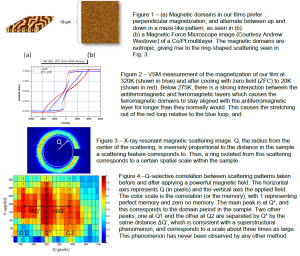Joseph Nelson and Dr. Karine Chesnel, Physics
One of the greatest challenges facing the magnetic data storage industry is the sensitivity of magnetic media to degradation by external fields. Because of this sensitivity, long-term archival data storage, which is required by law for many industries, has become very expensive to upkeep. To protect against possible degradation, most long-term archives must be removed, read, and re-recorded every few years. This process is very labor-intensive, time consuming, and expensive. This has led to the search for magnetic systems which have intrinsic magnetic domain memory, or ability of the magnetic domains within the sample to reproduce their former pattern (see Fig. 1) after saturation by an external field. Information stored in such domains could not be erased by external fields.
Exchange-bias [CoPd]/IrMn thin films with perpendicular magnetization have shown evidence of this kind of magnetic domain memory1. We have studied this system using both vibrating sample magnetometry (VSM), and x-ray resonant magnetic scattering (XRMS). During this year, we have obtained a very precise VSM system and have been able to make measurements here at BYU. XRMS, on the other hand, must be performed at synchrotron sources, and the data we have analyzed here were obtained at Berkeley.
VSM measures the net magnetization of a material in response to a changing magnetic field. In our system, called an exchange-bias system, when below a certain temperature, the pattern of the ferromagnetic domains is stored in antiferromagnetic layers within the film. If the antiferromagnetic layers interact strongly enough with the ferromagnetic layers, the ferromagnetic domains will re-align with this saved domain template and re-form in the same pattern. Our VSM measurements, an example of which is depicted in Fig. 2, indicate that there is a significant interaction between these two layers.
XRMS utilizes x-rays tuned to the resonant magnetic energy of the sample, and produce scattering unique to the specific domain pattern in the sample. This can be used with an in-situ magnetic field, so we can visualize the scattering of the domain patterns in response to a magnetic field. Because the scattering from these films is unique to the domain pattern in the sample, we can compare scattering images with one another to see how similar the domain patterns are. Thus, we can apply a strong magnetic field to the sample, and come back to its original position and compare the two scattering patterns to determine how much domain memory the film has. I have written a MATLAB code which uses cross-correlation to quantify this similarity, and thus the memory. Also, because these scattering patterns live in the reciprocal space, they contain spatial information. A scattering feature’s distance Q to the center of the scattering, as seen in Fig. 3, indicates the spatial scale it corresponds to. Thus, all of the features within a ring of equal Q correspond to the same spatial scale. We have used this relationship to quantify the memory of our system as a function of spatial scale by performing cross-correlation on isolated rings from the scattering. An example of our results is depicted in Fig. 4.
We have concluded that the maximum in the memory occurs at the spatial scale of one domain period (about 400nm). We also observe superstructure in the memory, seen in the corresponding to a spatial scale of about 3 domain periods (or 1200 nm). This spatial dependence of the magnetic memory has never been observed by any other method.
We have presented our findings at several regional conferences, including the 2010 conference of the Utah Academy of Sciences, Arts, and Letters, in whose journal our paper “A Radius- Specific Cross-Correlation Case Study of Magnetic Domain Memory” was awarded Best Paper (physical science section, 2010). This research was the subject of my senior thesis, titled Spatial and Temperature Dependency of Magnetic Domain Memory Induced by Exchange-Coupling, and an article in Physical Review B entitled “Oscillating spatial dependence of domain memory in ferromagnetic films mapped via x-ray speckle correlation,” to appear in early 2011.

